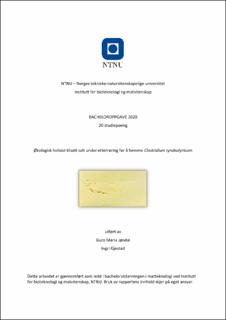| dc.contributor.advisor | Langfoss, Kari Helgetun | |
| dc.contributor.author | Jøndal, Guro Maria | |
| dc.contributor.author | Gjestad, Ingri | |
| dc.date.accessioned | 2020-07-14T16:00:42Z | |
| dc.date.available | 2020-07-14T16:00:42Z | |
| dc.date.issued | 2020 | |
| dc.identifier.uri | https://hdl.handle.net/11250/2664011 | |
| dc.description.abstract | De siste årene har fremveksten av små, lokale gårdsmeierier vært stor. Her produseres unike lokalproduserte oster, gjerne inspirert og laget etter oppskrifter fra Europa. Denne oppgaven tar for seg Gouda, en halvfast ost som blir produsert av flere småskala osteprodusenter i Norge.
Smørsyregjæring (også kalt senesing) er en ostefeil som ofte oppstår i faste og halvfaste oster og er forårsaket av anaerobe sporedannende bakterier, hovedsakelig Clostridium tyrobutyricum. Clostridium spp. kan omdanne laktat til smørsyre, eddiksyre, karbondioksid og hydrogengass. I ost kan gassdannelsen resultere i at osten eser (hull og sprekkdannelse) under modning, og smørsyre og andre stoffer gir osten en uønsket, vond smak. Sporedannende bakterier stammer fra gårdsmiljøet og kontaminerer melken via jur og spener under melking. På store meierianlegg kan sporene til en viss grad fjernes ved hjelp av mikrofiltreringsanlegg eller bactofugering, noe småskalaprodusenter ikke har muligheten til på grunn av de store kostandene det vil medføre å anskaffe slikt utstyr. Under ysting kan ostemassen tilsettes nitrat, lysozym eller hemmekultur for å hemme sporedannere. Ved økologisk produksjon er verken nitrat eller lysozym tillatt.
Hensikten med bacheloroppgaven var å kartlegge utfordringene norske småskala osteprodusenter har når det gjelder senesing i ost og gjøre forsøk med tilsetning av salt i etterrøringen for å se om dette har en hemmende effekt på Clostridium tyrobutyricum og dermed hindre senesing ved produksjon av en økologisk helfet Gouda. Det ble også forsøkt å finne en saltmengde som hemmet C. tyrobutyricum tilstrekkelig uten at osten ble for salt og syrningen ikke ble forstyrret mer enn at konsistensen på osten ble riktig og modningen gikk som normalt.
Det ble funnet at ved å tilsette 360g salt til 200 liter ystemelk under etterrøring ble C. tyrobutyricum hemmet tilstrekkelig, men ostene syrnet kraftig og modningen gikk dermed ikke som normalt. Ved å tilsette 180 g salt til 200 liter ystemelk ble ikke C. tyrobutyricum hemmet tilstrekkelig, og det ble dannet smørsyre. Det ble også gjort forsøk med salt i kombinasjon med hemmekultur, heller ikke her ble C. tyrobutyricum tilstrekkelig hemmet. | |
| dc.description.abstract | In recent years, cheese from local dairies have become more popular. Here, the local producers produce unique cheeses, often inspired and made according to recipes from Europe. This thesis are focusing on Gouda, a semi-hard cheese which several small producers produce in Norway.
Butyric acid fermentation is a problem that often occurs in hard and semi-hard cheese. This is caused by anaerobic spore-forming bacteria, mainly Clostridium tyrobutyricum. Clostridium spp. can convert lactate to butyric acid, acetic acid, carbon dioxide and hydrogen gas. The gas formation can result in late blowing (holes and cracks) in hard and semi-hard cheese during ripening. Butyric acid and other substances also give the cheeses an undesirable, bad taste. Spore-forming bacteria originate from the farm environment and contaminate the milk during milking. In large dairies, the spore-forming bacteria can be removed by microfiltration or bactofugation. Small local producers do not have this opportunity because of the costs. In the production of cheese, the curd can be added nitrate, lysozyme or culture to inhibit spore-forming. In ecologic production, nitrate or lysozyme are not allowed.
The purpose of this thesis was to identify the challenges that small local producers in Norway have in terms with butyric acid fermentation in cheese and to experiment with the addition of salt during stirring to see if this has an inhibitory effect on Clostridium tyrobutyricum and thus prevent butyric acid fermentation in the production of an ecologic fullfat Gouda. An attempt was also to find an amount of salt which inhibited C. tyrobutyricum sufficiently without the cheese becoming too salty and the acidification not being disturbed more than the consistency of the cheese being correct and the ripening going as normal.
It was found that by adding 360 g salt to 200 liters of fermented milk during stirring, C. tyrobutyricum was sufficiently inhibited, but the cheeses were acidic and the ripening did not proceed as normal. By adding 180 g of salt to 200 liters of fermented milk during stirring, C. tyrobutyricum was not inhibited sufficiently. Salt was also tested in combination with culture, C. tyrobutyricum was not sufficiently inhibited. | |
| dc.publisher | NTNU | |
| dc.title | Økologisk hvitost tilsatt salt under etterrøring for å hemme Clostridium tyrobutyricum | |
| dc.type | Bachelor thesis | |
